Running a lead generation or eCommerce campaign?
Performance Max is the new kid on the block that can improve your campaign’s performance and drive more revenue in your business.
In the first 4 minutes of this video, our Chief Strategist John Moran shows you how Performance Max brought about a staggering 89.89% increase in conversions with only a 9.70% increase in cost…
In just 3 weeks.
And today, you’ll learn how to find new audiences that serve as the catalyst for driving more conversions to your ads…
By using one of the newest tabs in Google Ads – Performance Max Insights Tab.
Let’s dive in!
Table of Contents
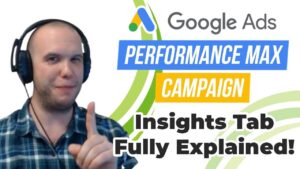
What is Performance Max Insights Tab?
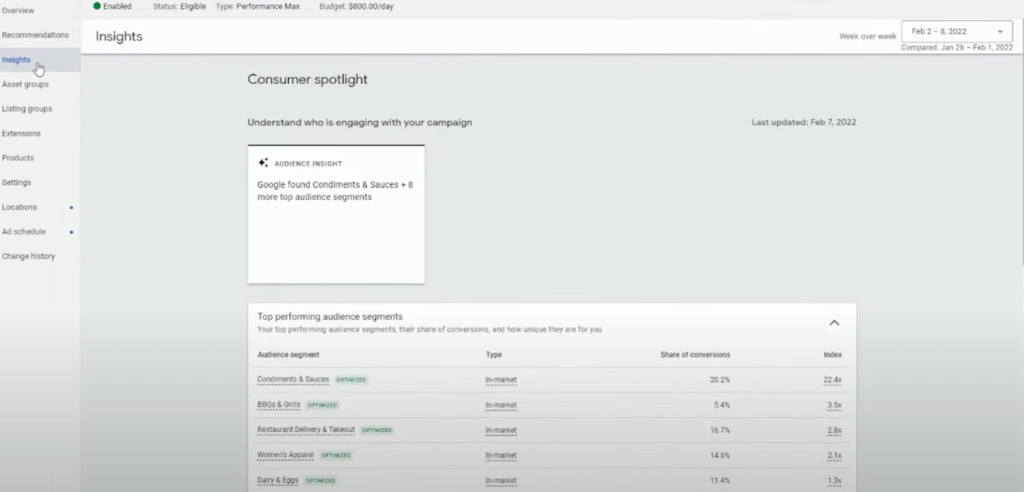
The Insights Tab is a new tab in Google Ads that gives you an overview of the audiences and themes that are relevant to your products or services.
The data you see in the insights tab are pulled from Google’s entire ecosystem––based on search trends, demand forecasts, and consumers’ interests.
This means you’ll be able to identify who your audiences are based on what the market says, even if they don’t seem related to what you’re selling.
To illustrate, we’re going to look at the data from one of our clients – a company that sells hot sauces.
Then, we’re going to break down the characteristics their audiences have, and find the search terms people use that led to a conversion.
Audience Insight
This section gives you a quick summary of your audience segments – those that are converting the most and individual conversion percentage.
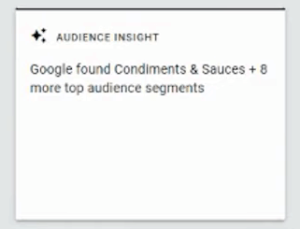
Here you’ll find your customers’ characteristics (and the type of audience they belong to), so you can improve your creatives and campaigns based on that information.
Audience Types
IN-MARKET
According to Google, these are “people who are researching products and are actively considering buying a service or a product.”
To define an in-market audience, you need to consider the last 14-21 days of a spike in recent activity, signaling to Google that the customer is indeed actively researching or planning to purchase.
This is a bottom-of-the-funnel target for a top-of-the-funnel median to attract. If the person is closer to the purchase decision, there should be an incentive, an introductory offer, a discount, or a direct response outbound ad.
According to Topics API, if a person is interested in a product and buys it, their activity will decrease in 6+ days to be removed from their essential interest. If we try to market them, the view rate should be low, have no cost per view, and have low engagement because they didn’t watch more than 10 seconds since they skipped through.
AFFINITY
Affinity is a permanent fixture of someone’s personality. It is based on a common interest that is never wavered and can be identified through YouTube videos, websites, blogs, purchased products, etc.
In other words, if you’re a yoga teacher, you’re not in the market for yoga––it’s what you do. And Google categorizes you as such.
It’s not a great direct response target as in-market but is a great target to introduce a brand. You can add it to your target audience by going into your Performance Max asset group and editing the audience signal:
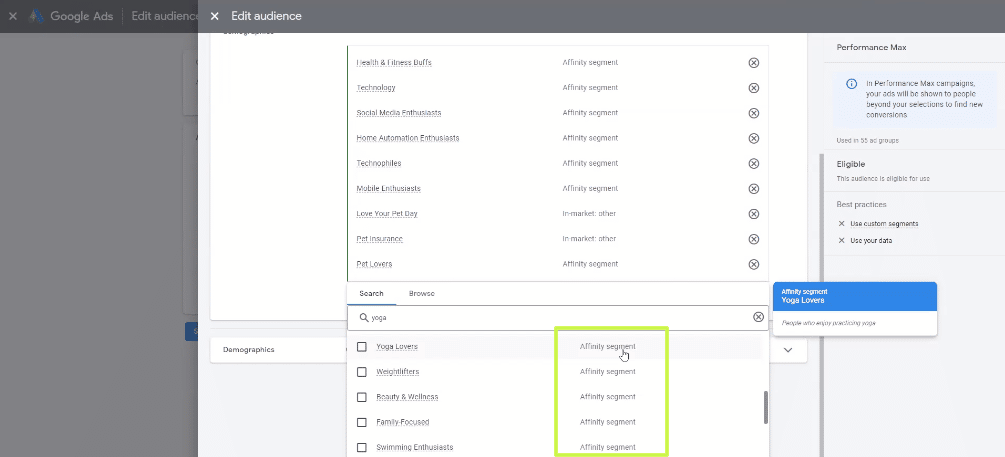
You can use a Target Cost Per Thousand Impressions (TCPM) bidding strategy to show your product to an affinity audience.
Not everyone might buy it, but it is a cheap strategy to re-market to bring them back directly and organically, engage through social content, visit the website, and purchase. You don’t need to spend a direct response budget but you could spend a top-of-funnel testing budget.
LIFE EVENTS
This audience type is a gold mine for scaling eCommerce.
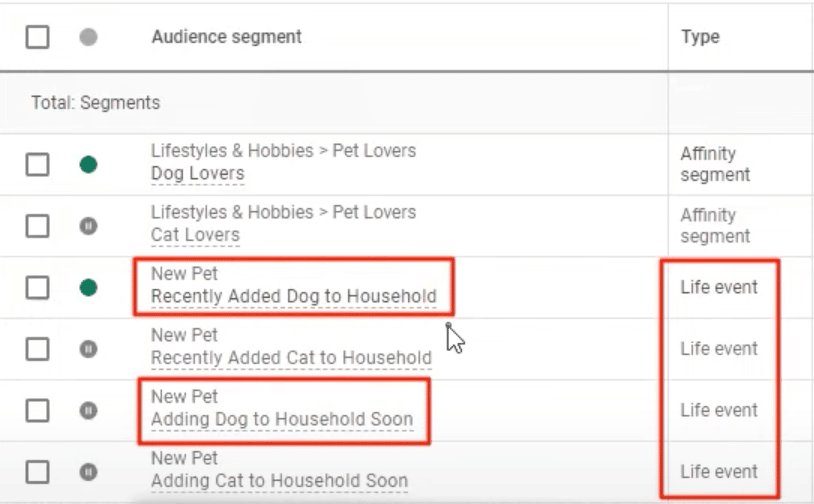
Let’s say that someone recently added a pet to their household. By using life events, Google can identify these people based on what happened in their life. Then, you can target this audience based on the new life event because they’ll be willing to purchase something related to it.
Top Performing Audience Segments
One of the coolest things about the insights tab is the section top performing audience segments.
In it, you’ll be able to see segments of those who have purchased from you and which audience they’re in.
Some audience segments may not look relevant to your product. That’s okay. For now, just trust that the data Google shows is what the market dictates.
Here’s what I mean.
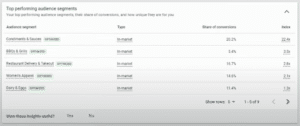
The image above shows our first five audience segments:
1. Condiments & Sauces
2. BBQs & Grills
3. Restaurant Delivery & Takeout
4. Women’s Apparel
5. Dairy & Eggs
Segments 1-3 are pretty relevant to our client’s products since they’re selling hot sauces. But “women’s apparel” and “dairy & eggs?”
Those don’t make sense, right?
Well, in this video, John Moran says that the new type of hot sauces that have been coming out are organic, gluten-free and sugar-free. They’re perfect for people who are health conscious.
It’s also the beginning of 2022 so we’re talking about people who want to buy (or have already bought) new clothes that will go with their lifestyle.
Still think it doesn’t make sense? Don’t fret!
The audience-product relevancy doesn’t really matter. We don’t need to find a connection between them and our client’s products.
What’s important is Google is now giving us additional audiences outside of the audiences we’ve chosen to target.
Top performing audiences we never would’ve considered.
Which means…we can increase our conversions as long as we create the right asset group tailored to that audience!
What’s more is you can even get down to the nitty gritty and see the top search themes where conversions are coming in from.
Top Search Themes Is Your Cheat Sheet
Out of all sections in Performance Max’s insights tab, this is what you should focus on.
Top search themes show you branded and non-brand search themes of users that are searching to buy.
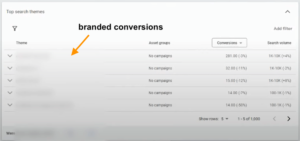
In the image above, the first few search themes are all branded conversions. We’ve blurred out the details for security purposes.
At first, we thought Performance Max was just a big brand campaign. But we gave it more time to run so we could see trends and gain a better understanding of how this works.
And we finally saw some changes.
We started to see different search terms like:
“ghost pepper hot sauce”
“hot sauce from Texas”
“best taco hot sauce”
We can also see their respective conversions and search volume.
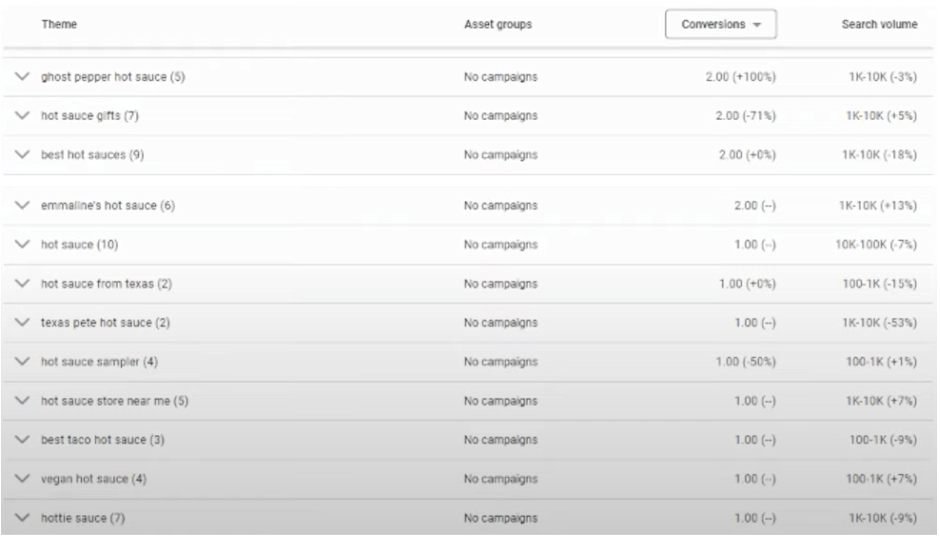
What does this mean? It means we now have what most people have always wanted – a search term in a Smart Shopping campaign…
Except that it’s not Smart Shopping.
Performance Max is search, YouTube, GSP, discovery, display, shopping, and remarketing. It’s native to all those channels.
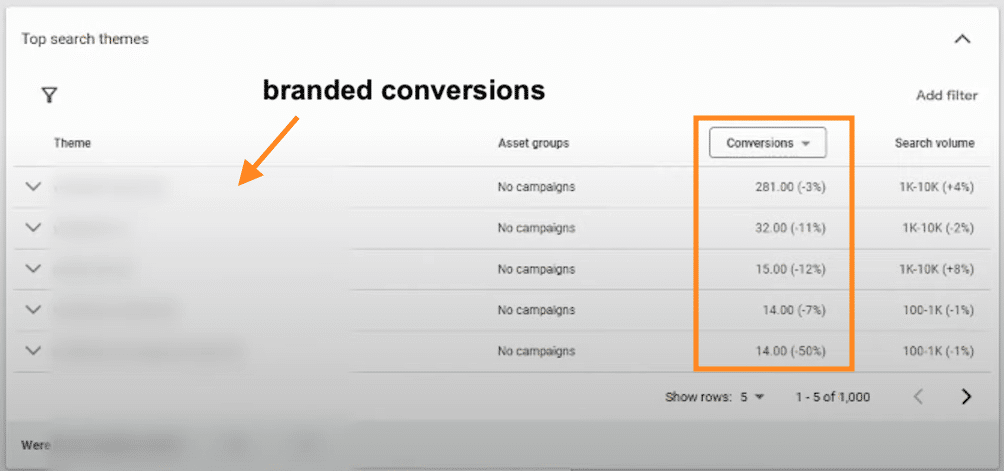
And here’s what’s even more exciting…
When you click the dropdown symbol, you’ll see tons of search terms around themes that people are searching for.
Note: At the time of this writing, nothing happens when you click “view details.” It’s still relatively new and we suspect it will be fixed soon.

They aren’t keywords or search terms that people use on Google. They’re activities about what people do online when they interact and buy from your brand.
In other words, the insights tab actually hands you a cheat sheet!
Regardless of whether there was a display ad shown, a YouTube ad, or a search. The theme around which that audience revolves tells you what you should be going after.
Unlike what most people think, Performance Max is not a consolidation of other campaigns rolled into one. It can’t and shouldn’t replace your other campaigns.
Instead, it’s a campaign that can expand out into Google’s ecosystem, creating more leverage points.
Which means, you don’t need to run, say, $100 per day (or whatever your budget is) on YouTube, search, display, and discovery campaigns. You’ll be able to do all that in one campaign.
Final Words
The insights tab is another tool in your marketing arsenal.
It helps you understand what the market is doing –– when it’s ready to buy, where to find them, and how you can leverage those points to achieve your business goals.
How you use this tool is totally up to you.
You can find those market segments and create customized asset groups specifically for your targeted audience.
Then, change your business model, ad copy, video production, imagery, landing pages, and product development based on that audience.
New to Performance Max? Learn everything you need to know about Performance Max here.
Author
Bryan is the marketing manager at Solutions 8, and has been on digital marketing since 2018. When he’s not working, you’ll find him working out at a local gym, reading personal development books, or playing music at home. He feels weird writing about himself in third person.
 Bryan Caranto
Bryan Caranto










